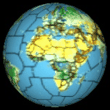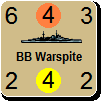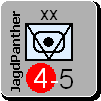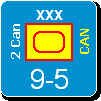ORIGINAL: Extraneous
[2175] [Japanese Special Naval Landing Force Marine]
.P Due to the scale of World in Flames and the unit sizes in play, the depiction of units of the Japanese Special Naval Landing Force (SNLF) – which were generally deployed in numbers smaller than a brigade - has to be necessarily ahistorical. It is right that these units are included within the game however. World in Flames allows the Japanese player to build one SNLF corps and two divisions.
.P During World War II the Japanese did not operate an autonomous marine branch in the way that their US counterparts did. However they did make use of naval troops. Such troops were used to land at key points – often ahead of a larger force – to seize key objectives.
.P The forerunners of the SNLF (Tokubetsu Rikusentai) were used for the first time during the fighting against Russia at the start of the 20th Century. Having proved their worth there and later in Manchuria, the Japanese began raising SNLF units at each of their four main naval bases.
.P The following units fought during World War II:
.P Kure naval base: 1st Kure SNLF, 2nd Kure, 3rd Kure, 5th Kure, 6th Kure and 7th Kure
.P Maizuru naval base: 1st Maizuru SNLF, 2nd Maizuru, 4th Maizuru and 5th Maizuru
.P Sasebo naval base: 1st Sasebo SNLF, 2nd Sasebo, 5th Sasebo, 6th Sasebo, 7th Sasebo and 8th Sasebo
.P Yokosuka naval base: 1st Yokosuka SNLF, 2nd Yokosuka, 3rd Yokosuka, 4th Yokosuka, 5th Yokosuka, 6th Yokosuka and 7th Yokosuka
.P In addition to the above, there were small Guard detachments that were based at other key ports and rivers such as Ryojun, Shanghai, Yangtse, Hankow and Canton.
.P The SNLF units varied in size. At most, a single unit was likely to contain no more than 1,600 men – roughly two battalions in size. The smallest units contained around 750 men. For some operations, two units could combine to form a brigade sized outfit. The 1st and 3rd Yokosuka SNLF’s were both airborne trained.
.P The division counters 2171 and 2172 provide details of some of the individual operations of the SNLF and these show at high level, how important these elite units were in the early stages of the war as the Japanese sought to expand their empire.
.P By June 1942, once the Japanese advance had been checked, the need for these troops was no longer as important. From elite, special purpose troops, they became nothing more than garrison troops that were, in many cases, annihilated as they sought to defend outposts in the Pacific; outposts that were taken one by one by the US juggernaut.
Is this exactly the way the write up is viewed by the player?
warspite1
No - this is how it is viewed
Due to the scale of World in Flames and the unit sizes in play, the depiction of units of the Japanese Special Naval Landing Force (SNLF) – which were generally deployed in numbers smaller than a brigade - has to be necessarily ahistorical. It is right that these units are included within the game however. World in Flames allows the Japanese player to build one SNLF corps and two divisions.
During World War II the Japanese did not operate an autonomous marine branch in the way that their US counterparts did. However they did make use of naval troops. Such troops were used to land at key points – often ahead of a larger force – to seize key objectives.
The forerunners of the SNLF (Tokubetsu Rikusentai) were used for the first time during the fighting against Russia at the start of the 20th Century. Having proved their worth there and later in Manchuria, the Japanese began raising SNLF units at each of their four main naval bases.
The following units fought during World War II:
Kure naval base: 1st Kure SNLF, 2nd Kure, 3rd Kure, 5th Kure, 6th Kure and 7th Kure
Maizuru naval base: 1st Maizuru SNLF, 2nd Maizuru, 4th Maizuru and 5th Maizuru
Sasebo naval base: 1st Sasebo SNLF, 2nd Sasebo, 5th Sasebo, 6th Sasebo, 7th Sasebo and 8th Sasebo
Yokosuka naval base: 1st Yokosuka SNLF, 2nd Yokosuka, 3rd Yokosuka, 4th Yokosuka, 5th Yokosuka, 6th Yokosuka and 7th Yokosuka
In addition to the above, there were small Guard detachments that were based at other key ports and rivers such as Ryojun, Shanghai, Yangtse, Hankow and Canton.
The SNLF units varied in size. At most, a single unit was likely to contain no more than 1,600 men – roughly two battalions in size. The smallest units contained around 750 men. For some operations, two units could combine to form a brigade sized outfit. The 1st and 3rd Yokosuka SNLF’s were both airborne trained.
The division counters 2171 and 2172 provide details of some of the individual operations of the SNLF and these show at high level, how important these elite units were in the early stages of the war as the Japanese sought to expand their empire.
By June 1942, once the Japanese advance had been checked, the need for these troops was no longer as important. From elite, special purpose troops, they became nothing more than garrison troops that were, in many cases, annihilated as they sought to defend outposts in the Pacific; outposts that were taken one by one by the US juggernaut.





